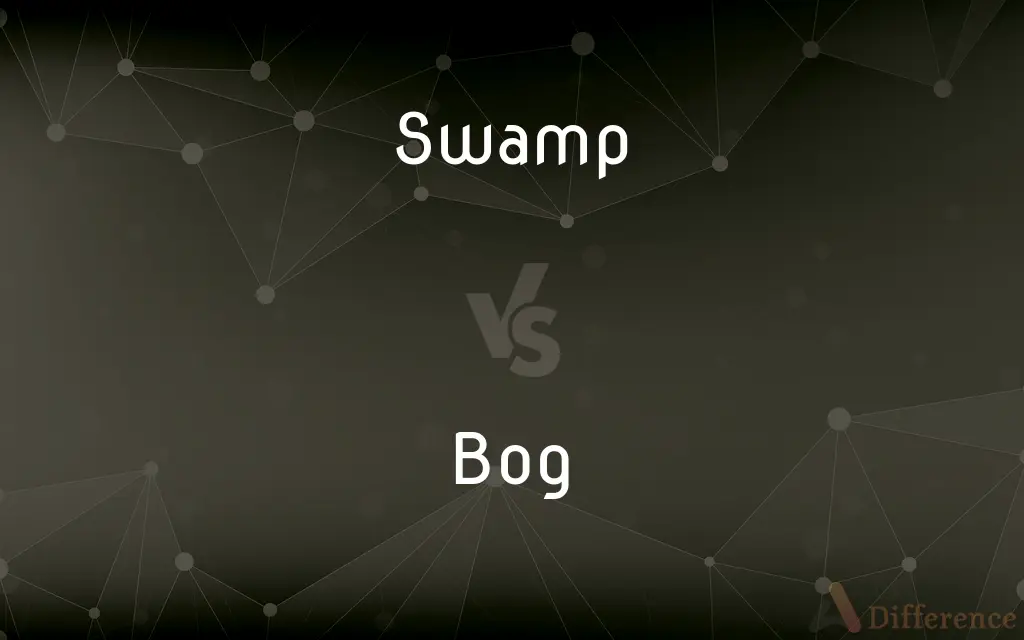Swamp vs. Bog — What's the Difference?
By Tayyaba Rehman — Updated on October 27, 2023
Swamps are wetlands with more water flow and diverse vegetation; bogs are acidic, peat-filled, with less nutrient-rich water and limited flora.

Difference Between Swamp and Bog
Table of Contents
ADVERTISEMENT
Key Differences
Swamps are characterized by their rich, water-saturated soil and diverse plant life, including trees and shrubs. In contrast, bogs are recognized for their acidic waters, sphagnum moss, and peat deposits, supporting a more limited range of plant species.
Swamps often have a higher rate of water flow and are usually connected to rivers or lakes. Bogs, however, are typically isolated from other water systems, leading to stagnant, nutrient-poor water.
The plant diversity in swamps is high, supporting various trees, shrubs, and aquatic plants. Bogs, on the other hand, due to their acidic and low-nutrient conditions, support a more specialized set of plants like carnivorous plants and heathers.
Swamps play a crucial role in filtering pollutants and providing habitats for a wide range of wildlife. Bogs, while less biodiverse, are important for carbon storage due to their extensive peat deposits.
Swamps can be found in both freshwater and saltwater environments. Bogs are generally associated with cooler climates and are often the result of glacial retreat.
ADVERTISEMENT
Comparison Chart
Water Flow
Often has flowing water.
Generally stagnant, isolated water.
Soil Type
Saturated, more nutrient-rich soil.
Acidic, peat-filled, nutrient-poor soil.
Vegetation Diversity
High, includes trees and shrubs.
Limited, specialized plants like moss.
Connection to Water
Usually connected to rivers or lakes.
Typically isolated from other waters.
Climate Association
Can be in various climates.
Often found in cooler climates.
Compare with Definitions
Swamp
Swamps can support both aquatic and terrestrial species.
Birds and alligators coexist in the swamp's unique ecosystem.
Bog
A bog is a wetland with acidic, peaty soil and limited vegetation.
The bog was covered in a thick layer of sphagnum moss.
Swamp
Swamps often act as natural water filtration systems.
The swamp plays a crucial role in purifying the water before it reaches the sea.
Bog
Bogs support specialized plants like carnivorous species.
In the nutrient-poor bog, pitcher plants thrived by trapping insects.
Swamp
A swamp is a wetland with standing water, rich in plant life.
The swamp was teeming with life, from towering cypress trees to croaking frogs.
Bog
A bog or bogland is a wetland that accumulates peat, a deposit of dead plant material—often mosses, and in a majority of cases, sphagnum moss. It is one of the four main types of wetlands.
Swamp
Swamps can vary from freshwater to saltwater environments.
The coastal swamp was influenced by the tides, creating a brackish environment.
Bog
An area of wet muddy ground that is too soft to support a heavy body
A peat bog
The island is a wilderness of bog and loch
A bog of legal complications
Swamp
Swamps are often found alongside rivers or lakes.
The river's overflow created a vast swamp rich in biodiversity.
Bog
The toilet.
Swamp
A swamp is a forested wetland. Swamps are considered to be transition zones because both land and water play a role in creating this environment.
Bog
Be or become stuck in mud or wet ground
The family Rover became bogged down on the beach road
Swamp
An area of low-lying land that is frequently flooded, especially one dominated by woody plants.
Bog
Go away
I told him to bog off
Swamp
A lowland region saturated with water.
Bog
Start a task enthusiastically
If he saw a trucker in difficulty, he would just bog in and give a hand
Swamp
A situation or place fraught with difficulties and imponderables
A financial swamp.
Bog
An area having a wet, spongy, acidic substrate composed chiefly of sphagnum moss and peat in which characteristic shrubs and herbs and sometimes trees usually grow.
Swamp
To drench in or cover with or as if with water.
Bog
Any of certain other wetland areas, such as a fen, having a peat substrate. Also called peat bog.
Swamp
To inundate or burden; overwhelm
She was swamped with work.
Bog
An area of soft, naturally waterlogged ground.
Swamp
(Nautical) To fill (a ship or boat) with water to the point of sinking it.
Bog
Chiefly British Slang A restroom or toilet.
Swamp
To become full of water or sink.
Bog
To cause to sink in a bog
The bus got bogged down in the muddy road.
Swamp
A piece of wet, spongy land; low ground saturated with water; soft, wet ground which may have a growth of certain kinds of trees, but is unfit for agricultural or pastoral purposes.
Bog
To hinder or slow
The project got bogged down in haggling about procedures.
Swamp
A type of wetland that stretches for vast distances, and is home to many creatures which have adapted specifically to that environment.
Bog
To be hindered and slowed.
Swamp
(figurative) A place or situation that is foul or where progress is difficult.
Bog
An area of decayed vegetation (particularly sphagnum moss) which forms a wet spongy ground too soft for walking; a marsh or swamp.
Swamp
To drench or fill with water.
The boat was swamped in the storm.
Bog
(figuratively) Confusion, difficulty, or any other thing or place that impedes progress in the manner of such areas.
Swamp
(figurative) To overwhelm; to make too busy, or overrun the capacity of.
I have been swamped with paperwork ever since they started using the new system.
Bog
(uncountable) The acidic soil of such areas, principally composed of peat; marshland, swampland.
Swamp
(figurative) To plunge into difficulties and perils; to overwhelm; to ruin; to wreck.
Bog
A place to defecate: originally specifically a latrine or outhouse but now used for any toilet.
Swamp
Wet, spongy land; soft, low ground saturated with water, but not usually covered with it; marshy ground away from the seashore.
Gray swamps and pools, waste places of the hern.
A swamp differs from a bog and a marsh in producing trees and shrubs, while the latter produce only herbage, plants, and mosses.
Bog
An act or instance of defecation.
Swamp
To plunge or sink into a swamp.
Bog
A little elevated spot or clump of earth, roots, and grass, in a marsh or swamp.
Swamp
To cause (a boat) to become filled with water; to capsize or sink by whelming with water.
Bog
(obsolete) nodot=1: a bugbear, monster, or terror.
Swamp
Fig.: To plunge into difficulties and perils; to overwhelm; to ruin; to wreck.
The Whig majority of the house of Lords was swamped by the creation of twelve Tory peers.
Having swamped himself in following the ignis fatuus of a theory.
Bog
(obsolete) Puffery, boastfulness.
Swamp
To sink or stick in a swamp; figuratively, to become involved in insuperable difficulties.
Bog
To sink or submerge someone or something into bogland.
Swamp
To become filled with water, as a boat; to founder; to capsize or sink; figuratively, to be ruined; to be wrecked.
Bog
(figuratively) To prevent or slow someone or something from making progress.
Swamp
Low land that is seasonally flooded; has more woody plants than a marsh and better drainage than a bog
Bog
To sink and stick in bogland.
Swamp
A situation fraught with difficulties and imponderables;
He was trapped in a medical swamp
Bog
(figuratively) To be prevented or impeded from making progress, to become stuck.
Swamp
Drench or submerge or be drenched or submerged;
The tsunami swamped every boat in the harbor
Bog
To defecate, to void one's bowels.
Swamp
Fill quickly beyond capacity; as with a liquid;
The basement was inundated after the storm
The images flooded his mind
Bog
To cover or spray with excrement.
Bog
To make a mess of something.
Bog
To provoke, to bug.
Bog
To go away.
Bog
(obsolete) Bold; boastful; proud.
Bog
A quagmire filled with decayed moss and other vegetable matter; wet spongy ground where a heavy body is apt to sink; a marsh; a morass.
Appalled with thoughts of bog, or caverned pit,Of treacherous earth, subsiding where they tread.
Bog
A little elevated spot or clump of earth, roots, and grass, in a marsh or swamp.
Bog
To sink, as into a bog; to submerge in a bog; to cause to sink and stick, as in mud and mire.
At another time, he was bogged up to the middle in the slough of Lochend.
Bog
Wet spongy ground of decomposing vegetation; has poorer drainage than a swamp; soil is unfit for cultivation but can be cut and dried and used for fuel
Bog
Cause to slow down or get stuck;
The vote would bog down the house
Bog
Get stuck while doing something;
She bogged down many times while she wrote her dissertation
Bog
Bogs often form in cooler climates from glacial activity.
The northern bog was a testament to the region's glacial history.
Bog
Bogs have stagnant, nutrient-poor water.
The bog's still waters reflected the sparse, stunted trees.
Bog
Bogs are important carbon sinks due to peat accumulation.
The bog’s extensive peat layers have been storing carbon for centuries.
Common Curiosities
What types of plants are common in swamps?
Various trees, shrubs, and aquatic plants.
Are bogs important for the environment?
Yes, especially for carbon storage and supporting unique ecosystems.
Can swamps be found in both freshwater and saltwater areas?
Yes, swamps can exist in both types of environments.
What defines a swamp?
A wetland with standing water and diverse vegetation, including trees.
What is a bog?
A wetland with acidic, peaty soil, limited vegetation, and stagnant water.
Are bogs always acidic?
Typically, yes. Bogs are known for their acidic conditions.
Do bogs have a high diversity of wildlife?
No, bogs have limited biodiversity due to their acidic, nutrient-poor conditions.
Can humans easily traverse swamps?
Swamps can be challenging to navigate due to water and dense vegetation.
Can swamps help in water purification?
Yes, swamps often act as natural filtration systems.
What is the primary water source for a bog?
Rainwater, leading to stagnant and isolated water conditions.
Are bogs usually isolated ecosystems?
Yes, they are often cut off from other water systems.
Do swamps support a variety of animal life?
Yes, from aquatic species to birds and mammals.
Can bogs be used for agricultural purposes?
Generally not, due to their acidic, waterlogged, and nutrient-poor conditions.
What makes the water in bogs nutrient-poor?
The lack of water flow and the presence of acidic peat.
Do swamps play a role in flood control?
Yes, by absorbing excess water during heavy rains or floods.
Share Your Discovery

Previous Comparison
Encrypted vs. Unencrypted
Next Comparison
Arbitration vs. AdjudicationAuthor Spotlight
Written by
Tayyaba RehmanTayyaba Rehman is a distinguished writer, currently serving as a primary contributor to askdifference.com. As a researcher in semantics and etymology, Tayyaba's passion for the complexity of languages and their distinctions has found a perfect home on the platform. Tayyaba delves into the intricacies of language, distinguishing between commonly confused words and phrases, thereby providing clarity for readers worldwide.














































